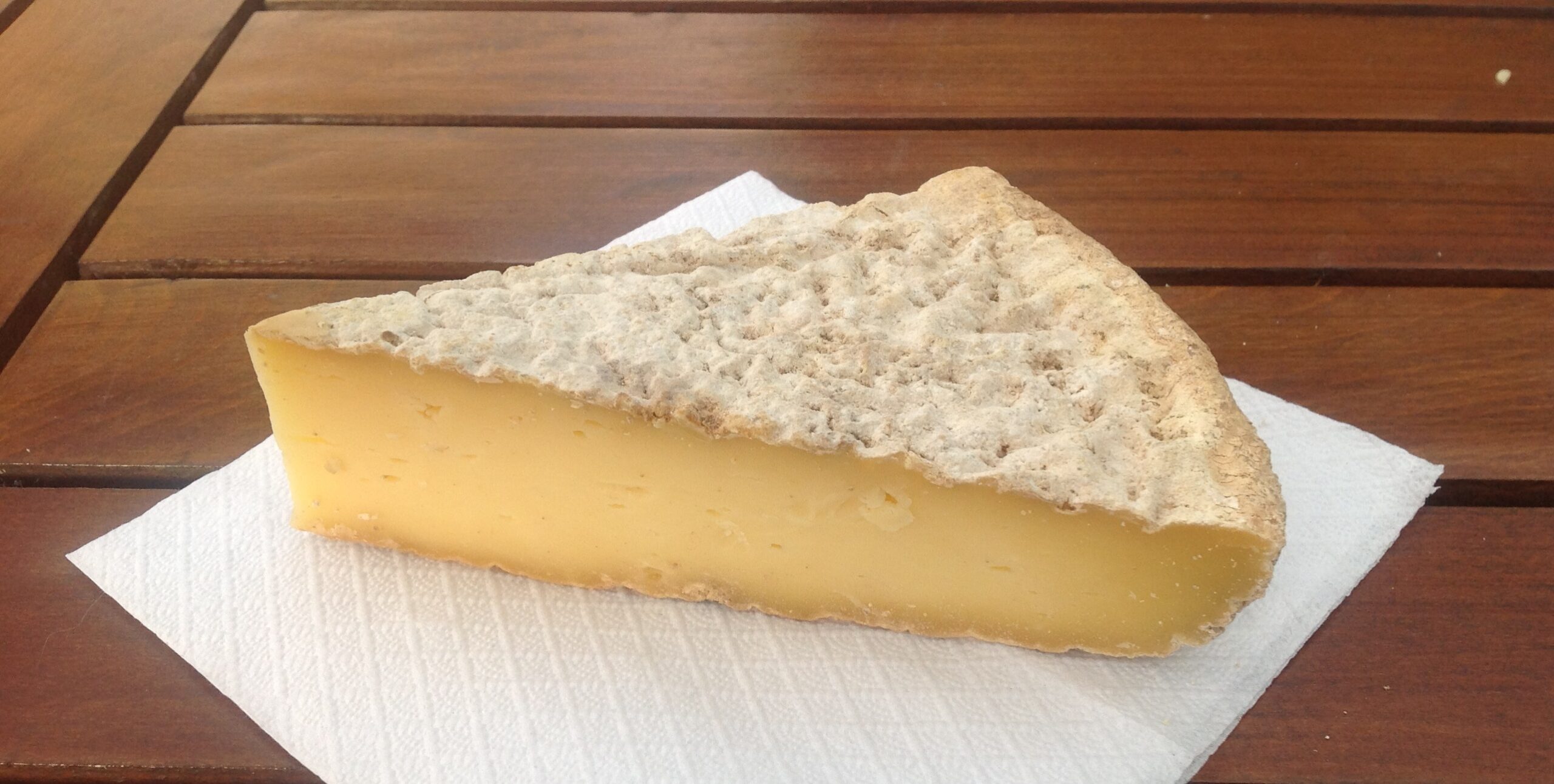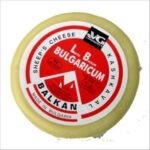Zlatograd Cheese is a marvelous dairy jewel that hails from the mountainous region of Zlatograd in Bulgaria. Symbolic of its origin, it’s a semi-hard creation with a distinct, rich character and a surprising yet rewarding flavor profile. Gaining popularity in the gourmet world, Zlatograd Cheese is making its presence felt with its unmistakably unique and vivacious flavor.
Taking inspiration from the region’s pastoral lifestyle, this cheese is crafted from the high-quality milk of grazing animals, specifically goats, and sheep. The influence of the geographical area and the chaste diet of the local fauna results in a notable grassy, tangy flavor with an underlying note of slight sweetness. These subtle variations in flavor pitch the Zlatograd cheese into a culinary league of its own.
Known for its creamy-yellow color and small holes scattered across its interior, Zlatograd Cheese exhibits a firm, slightly elastic texture that tends to melt delicately in the mouth. The cheese matures over a span of two to four months, during which it develops a thin, natural rind. This maturation period imbues the cheese with a hint of earthiness that harmonizes perfectly with its naturally gentle, tangy flavor.
- Geographical origin: Zlatograd, Bulgaria
- Type: Semi-hard cheese, goat/sheep milk
- Color: Creamy-yellow
- Flavor: Grassy, tangy with a note of sweetness
- Texture: Firm, slightly elastic
- Maturation: Two to four months
- Rind: Thin, natural
Adored by cheese enthusiasts, Zlatograd Cheese performs exceptionally well when added to a variety of dishes. It effortlessly elevates the flavor of salads, pasta, and sandwiches, and stands out, whether served on a cheese board or integrated into intricate recipes. Its balanced yet complex nature allows it to complement a wide range of beverages, including a broad variety of Bulgarian wines, making it a truly versatile addition to the culinary world.
Welcome to our quiz on the topic of ‘Zlatograd Cheese’! Explore your grasp on this Bulgarian delicacy, the methods of its production, and its cultural significance. Are you ready to challenge your knowledge and discover new aspects of this exciting topic? Let’s start!
Zlatograd Cheese: A Dive into Its Ingredients, Distinctive Properties, and Noteworthy Varieties
What sets the Zlatograd cheese apart in the gastronomic universe, is its unique taste profile, achieved through its characteristic components and precise, time-honored preparation methods. This traditional Bulgarian cheese’s primary ingredient is sheep’s milk, resulting in a rich olfactory tapestry, distinguished by sharp, mildly salty, and pleasantly-tangy notes, followed by a luscious creaminess. While some producers often supplement it with a small percentage of goat or cow’s milk, the classic Zlatograd strictly preserves the ovine origin.
The essence of Zlatograd cheese lies in its controlled fermentation process, employing a combination of specific lactic acid bacteria strains responsible for the characteristic flavor profile and eventual consistency. The cheese-making process involves a gentle coagulation phase at a specific temperature around 32-35 degrees Celsius, ensuring a perfect curd formation. This consistent technique brings out a spectrum of flavors, from subtle, flowery hints to deep, assertive ones. Following the proper aging period, the result is a firm-textured, pale-yellow cheese that astounds with its intricate flavor balance.
While the standard Zlatograd cheese is popular for its robust, yet accessible taste, various sub-varieties carve niches of their own. Some noteworthy variants include:
- Zlatograd Piquant: Matured for an extended period, this cheese exudes a more pronounced, spicy flavor – truly a match for palates seeking intense experiences.
- Zlatograd Smoked: This variant harks back to ancestral cheese-making techniques, flavoring the cheese by gentle smoking over aromatic wood. Expect a subtle, smoky undertone overlaying on the foundation Zlatograd’s taste.
- Lite Zlatograd: A lower-fat version, designed for those who crave Zlatograd’s distinctive flavors but wish to maintain a strict dietary regimen.
All in all, Zlatograd cheese presents a fascinating world of flavors, textures, and complexities of the curious cheese enthusiast. Its singular ingredients, meticulous processes, and delightful varieties carve a unique space in cheese-making traditions, making this cheese not just a culinary delight but a symbol of its regional culture.
Zlatograd Cheese: A Taste of Bulgaria
Bulgaria, a picturesque country nestled in the heart of the Balkan Peninsula, is known for its rich culinary traditions. From succulent meats to flavorful vegetables, Bulgarian cuisine has a lot to offer. But perhaps one of its finest culinary treasures is Zlatograd Cheese, a true delight for cheese connoisseurs.
Named after the town of Zlatograd in the Rhodope Mountains, Zlatograd Cheese is a traditional Bulgarian cheese that has been enjoyed for centuries. Made from sheep’s milk, this cheese showcases the unique flavors and aromas of the Balkan region.
What sets Zlatograd Cheese apart is not only its provenance but also the craftsmanship that goes into its production. Local shepherds carefully tend to their flocks, ensuring that their sheep graze on the region’s lush pastures, resulting in milk of exceptional quality. This milk is then transformed into cheese using time-honored techniques, giving Zlatograd Cheese its distinctive taste and texture.
The Rhodope Mountains, with their diverse flora and cool climate, create ideal conditions for the production of Zlatograd Cheese. The microorganisms in the local environment contribute to the cheese’s unique flavor profile, adding depth and complexity.
- Zlatograd Cheese is made from sheep’s milk.
- It is named after the town of Zlatograd in the Rhodope Mountains, Bulgaria.
- The cheese is produced using traditional methods.
- The Rhodope Mountains provide the perfect environment for the production of Zlatograd Cheese.
- Zlatograd Cheese has been part of Bulgarian diet for centuries.
- Zlatograd, where this cheese originates, is a small town in the Rhodope Mountains of southern Bulgaria.
- The cheese takes its full flavor only after aging for several months.
- Zlatograd cheese is traditionally used in a variety of Bulgarian dishes, including the popular Shopska Salad.
- Although an essential part of Bulgarian cuisine, Zlatograd cheese is relished by food enthusiasts worldwide.
- The process of curdling milk unique to its production, gives Zlatograd cheese its distinctive texture and flavor.
Affordable Luxury: A Taste of Bulgaria with Unique Zlatograd Cheese Recipes
Endemic to the Balkan region, Zlatograd Cheese is a gem waiting to be discovered by culinary enthusiasts. Sealed in a wooden barrel and immersed in olive oil, it undergoes an unparalleled maturation process that gives it its rich, feta-like texture and slightly tart, but creamy taste. Eager cheese-lovers, however, should note that the enjoyment of Zlatograd Cheese goes beyond mere tasting. This cheese, a staple in Bulgarian cuisine, can bring a novel, delightful twist to a variety of recipes.
Those who crave comfort food might appreciate a simple Zlatograd Macaroni Cheese. This elevates the classic mac and cheese by layering it with the robust flavors bestowed by the Zlatograd Cheese. To start, one needs the following ingredients:
- 200 grams of macaroni
- 1 tbsp butter
- 1 garlic clove, finely chopped
- 200 grams Zlatograd Cheese, grated
- 200 ml milk
- Salt and pepper to taste
To prepare, cook the macaroni in boiling salted water according to the packet instructions. Meanwhile, melt the butter in a saucepan, add garlic and cook for a couple of minutes. Stir in the grated Zlatograd Cheese and milk until you have a creamy mixture. Season with salt and pepper. Finally, drain the macaroni and mix with the cheese sauce. Serve warm and enjoy the comforting balance of creaminess and a mild zing imparted by the Zlatograd Cheese.
Another notable recipe featuring Zlatograd Cheese is the Zlatograd Cheese Stuffed Peppers. This dish fuses the tangy, crisp flavor of peppers with the creaminess of the cheese, creating a savory and rich culinary experience. The ingredients needed are:
- 4 large bell peppers (any color)
- 200 grams Zlatograd Cheese, crumbled
- 2 tbsp olive oil
- 1 onion, finely chopped
- 2 garlic cloves, minced
- 200 grams tomatoes, chopped
- 50 ml white wine
- Freshly ground black pepper, to taste
Hollow out the peppers, remove the seeds, and set aside. Sauté onion and garlic in olive oil until they soften. Add tomatoes and let them cook until tender. Add the crumbled Zlatograd Cheese, white wine, black pepper, and let the mixture simmer for a couple of minutes. Spoon this filling into the hollowed peppers and bake in a preheated oven at 180°C for 20-25 minutes. Enjoy these Zlatograd Cheese Stuffed Peppers as a standalone dish or with a side of fresh salad to balance out the rich cheese flavors.
Exquisite Pairings: Zlatograd Cheese, Wine and Culinary Combinations
Zlatograd cheese, originating from the Bulgarian highlands bordering Greece, has a distinct flavor profile that offers an exciting journey for the palate. This semi-hard cheese, made from sheep’s milk, carries a tangy bitterness reminiscent of Mediterranean wildflowers, with a slightly sweet undertone. Ageing for up to six months gives it a firm consistency and a bold intensity that can stand up to robust dishes and wines. When pairing Zlatograd cheese, there are several factors to consider including the cheese’s texture, saltiness, and acidity which can bring about a delicious and harmonious balance of flavors when teamed with the right companions.
For wine enthusiasts, seek the perfect blend of flavors that a wine and cheese pairing can provide. A Zlatograd cheese pairs wonderfully with red wines, particularly those with a balanced tannin structure. A Cabernet Sauvignon or a Merlot, with their dark fruit flavors and moderate acidity, complement the cheese’s bold flavors without overpowering them. Alternatively, a full-bodied and oak-aged Chardonnay can accentuate the cheese’s creamy texture and sweet undertones, making for a contrast pairing that can surprise and delight.
Food pairings with Zlatograd cheese can vary greatly based on the preparation method. Here is a short list of recommended dishes:
- Pasta dishes: Zlatograd cheese can substitute Parmesan or Romano in pasta dishes. Its slightly bitter edge contrasts nicely with the creamy sauces and it pairs especially well with dishes like lasagna or creamy mushroom pasta.
- Salads: Grate or crumble the cheese on top of a salad with robust greens like arugula or spinach. A drizzle of balsamic vinegar enhances the cheese’s natural tanginess.
- Cheese boards: Lastly, Zlatograd serves as an intriguing component in any cheese board. Pair with figs, honey and darker bread types. These sweet pairings enhance the cheese’s own sweetness and balanced bitterness.
Whether you prefer it grated over your favorite pasta or eaten with a full-bodied wine, Zlatograd cheese is sure to enhance any dining experience. Remember, the golden rule of pairing is to match strength with strength, and this semi-hard cheese certainly comes with a strong character of flavors. Enjoy the journey of crafting your perfect combination!
Similar Cheeses for Zlatograd Cheese
Zlatograd Cheese is a popular Bulgarian cheese known for its unique taste and texture. However, if you are looking to explore other cheeses that are similar to Zlatograd, there are a few options that you may find interesting. These cheeses share some similarities in flavor, production method, or regional origin, making them worthy alternatives for cheese lovers.
1. Kasseri: Hailing from Greece, Kasseri is a semi-hard cheese with a tangy and slightly salty taste. It is made from sheep’s milk or a combination of sheep’s and goat’s milk. Kasseri has a firm yet creamy texture and a golden-yellow rind. Like Zlatograd Cheese, Kasseri is often enjoyed on its own or melted in various dishes.
2. Telemea: Telemea is a Romanian cheese that is often compared to feta cheese. Made from sheep’s milk, cow’s milk, or a mixture of the two, Telemea has a slightly crumbly texture and a mild yet tangy flavor. It is commonly used in Romanian cuisine, either as a table cheese or in traditional dishes such as sarmale (stuffed cabbage rolls) and mămăligă (polenta).
3. Kashkaval: Kashkaval is a popular cheese in Bulgaria, as well as in other Balkan countries. It is a semi-hard cheese made from cow’s milk, sheep’s milk, or a combination of both. Kashkaval has a smooth and elastic texture and a distinct flavor that can range from mild to sharp. It is often used as a table cheese, as well as melted in sandwiches or as a topping for various dishes.
4. Sirene: Sirene, also known as Bulgarian white brine cheese, is another cheese that shares similarities with Zlatograd. Made from sheep’s milk, cow’s milk, or a blend of the two, Sirene has a crumbly texture and a slightly salty taste. It is commonly used in Bulgarian cuisine, particularly in salads, pastries, and as a filling for banitsa, a traditional Bulgarian pastry.
These cheeses offer a delightful journey for cheese enthusiasts who enjoy exploring different flavors and textures. Whether you’re a fan of Zlatograd Cheese or looking for similar alternatives, these cheeses are sure to satisfy your taste buds with their unique characteristics and regional influences.
- Kasseri: A tangy and slightly salty Greek cheese made from sheep’s milk or a combination of sheep’s and goat’s milk.
- Telemea: A Romanian cheese similar to feta, made from sheep’s milk, cow’s milk, or a mixture of the two.
- Kashkaval: A popular cheese in Bulgaria and other Balkan countries, with a smooth and elastic texture and a distinct flavor.
- Sirene: Also known as Bulgarian white brine cheese, made from sheep’s milk, cow’s milk, or a blend of the two, and commonly used in Bulgarian cuisine.



